WOC 153
Page 153
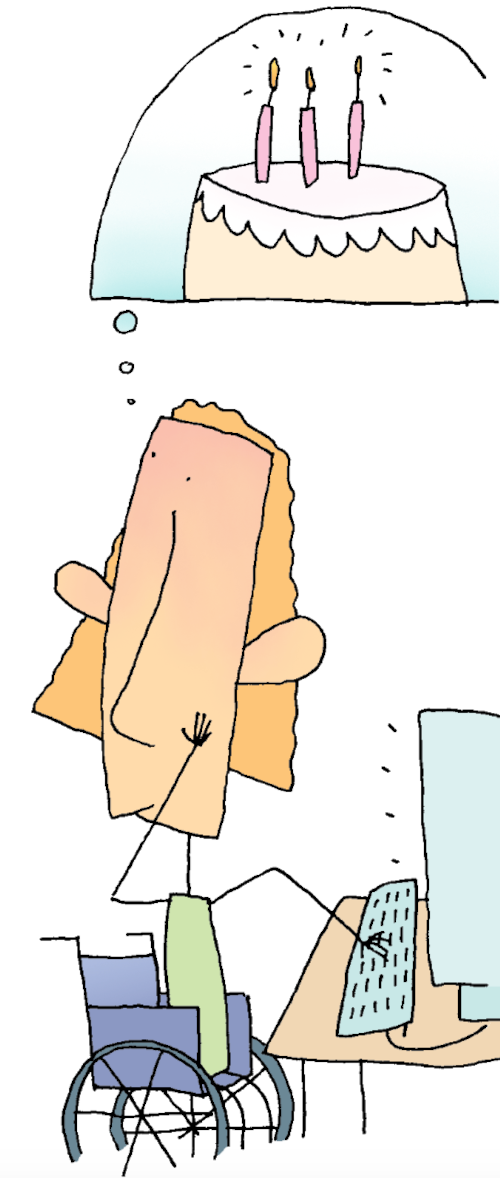
Other Forms of Narrative Writing
From one birthday to the next, you travel 584 million miles—a journey around the sun. A lot can happen on that long journey. You might get a new baby brother or sister . . . or even a puppy. You might learn to ski or discover a favorite novel series. You might grow five inches taller and have to relearn how to use your legs. To tell about experiences that happen over a long period of time, you can write a phase autobiography.
If you’d rather write about someone else’s life, you could create a biographical story. Or if you want to write about a special person, place, or thing, you might try a descriptive essay. All of this practice with narrative writing will help you perform well when you respond to a narrative prompt on a test.
What’s Ahead
WOC 154
Page 154
Phase Autobiography
A phase autobiography is a special type of writing that focuses on an extended period of time, or phase, in the writer’s life. In the following phase autobiography, Teri Gardner writes about coping with a new home.
A Puzzling Summer
Beginning:
The beginning introduces the situation and indicates a problem—no friends. The summer when I was turning 12, my family moved from Auburn, Washington, to Munster, Indiana. I had a posse of friends back in Washington but knew nobody here. Worse, the heat and humidity and mosquitoes drove me indoors. We didn’t have air conditioning, so the only place I could go to escape was the basement.
Middle:
The middle describes what happens during this phase of the writer’s life. We had a Ping-Pong table, but I had no friends, so I got out a puzzle and put it together on the table. When I finished it, I got out another, and another: a mountain scene, a canal in Venice, a seaside with sailboats, a farm with cows grazing, earthrise above the moon—anyplace but Munster, Indiana.
By the second week, I had 20 puzzles spread across the Ping-Pong table, and I was setting up card tables for more. One day, my mom came down to check on me. “Wow! Look at all these puzzles! Let me get your picture.”
She took a few shots of me standing there, awkward at 11 and three quarters, my hand resting on the table.
“I should send this to the newspaper,” Mom said. “They might want to do a story about you.”
At first, that idea sounded cool, but then I thought of all the kids at middle school seeing this feature about a lonely kid with no friends who spent her whole summer in the basement doing puzzles. I told Mom not to send the picture, and not to post it on Facebook.
I kept going with my puzzles, but I was running out. I even did a couple hundred-piece puzzles from when I was a kid. Then, there were no more.
“Do you know of anywhere that would have good puzzles?” I asked my mom.
“Anywhere would—I mean, Walmart or Target—”
“I don’t want cheap ones with stupid pictures. I want good ones, challenging ones,” I whined. “If I’m not going to have any friends, at least my puzzles should be cool.”
Mom searched on her phone and found a shop that specialized in puzzles and games. We drove there, and it was an amazing place. They had a whole wall of puzzles with intriguing pictures, and a trove of board games and role-playing games. They had tables set up where people were playing games.
I stood studying the puzzle boxes, but I was listening to a group nearby.
“When you guys come around a corner, you see a huge chamber filled with gold coins and jewels,” said the guy who was leading the game. “In the center, on the glittering mound lies a slumbering red dragon. What do you do?”
“I look for someplace that will provide cover if the dragon breathes fire,” one player offered.
“I grab a handful of gold!” another said.
“Everybody roll for initiative,” the leader announced. Then he looked up at me. “You want to play?”
The action builds and reaches a critical moment. I suddenly realized that I’d wandered over to stare.
He smiled. “I’ve got a stack of pre-rolled characters. Pick one, sit down, and roll for initiative.”
And just like that, the puzzle girl emerged from the basement to join a game group.
Ending:
The ending shows how the writer solved her problem. Now the puzzles are cleared off the old Ping-Pong table. The only time I go down there anymore is on Saturday night. That’s when my new posse of friends gathers in my new house to play games. We might even try Ping-Pong!

WOC 156
Page 156
Writing Guidelines
Prewriting ■ Choosing a Topic
Think about the important phases, or stages, of your life. Then choose an important phase to write about. Teri created a life map to examine the phases in her own life. (A life map recalls the stages in a person’s life, from birth to the present. Teri’s map also rates the events.)
Life Map

Gathering Details
After choosing a topic, list the key actions or events related to the phase. Teri thought back to the summer when she turned 12 and moved to a new city. (Download a time line.)
Time Line

WOC 157
Page 157
Writing ■ Creating the First Draft
Beginning ■ The beginning of your phase autobiography should accomplish three things, each of which is demonstrated in Teri’s opening paragraph:
- Set the scene.
The summer when I was turning 12, my family moved from Auburn, Washington, to Munster, Indiana.
- Introduce a problem.
I had a posse of friends in Washington but knew nobody here.
- Get the story rolling.
We didn’t have air conditioning, so the only place I could go to escape was the basement.
Middle ■ Once you have introduced your phase, develop your narrative, working in the most important events of the phase. The action should intensify until it reaches a high point, or critical moment, where the story turns. (See “Pattern of Organization.”) At the critical moment in Teri’s story, the leader of the game group invites her to join them.
Ending ■ In the ending, show how the phase changed you.
Revising ■ and Editing ■ Improving Your Writing
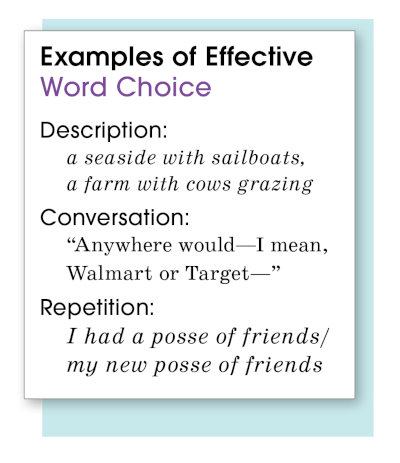
Revise and edit your first draft using the following checklist as a guide.
_____ Ideas Have I focused on the key details of the phase?
_____ Organization Is my narrative in chronological order?
_____ Voice Does my personality come through in my story?
_____ Word Choice Have I taken special care to use colorful words in my story?
_____ Sentences Are my sentences smooth and varied?
_____ Conventions Do I use proper punctuation, capitalization, spelling, and grammar?
WOC 158
Page 158
Biographical Story
In the following biographical story, student Sofia Martinez shares the accomplishments of a famous person. To gather information, Sofia researched her subject on the Internet and at the library.
Frida Kahlo
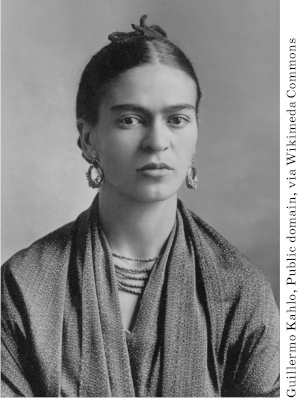
Beginning:
The writer starts with a high point in Frida Kahlo’s career. Near the end of the Depression, just before World War II, Frida Kahlo exhibited her artwork in New York City. She showed 25 paintings and sold a dozen. Her innovative art mixed traditional Mexican folk images with surreal symbolism. With this exhibition, Frida finally broke through to international acclaim.
Middle:
The writer summarizes Frida’s life, highlighting exhibitions. The road to success had been long and difficult. Frida Kahlo was born in Mexico City in 1907 and at an early age loved to draw. Then she fell ill with polio, which left her health fragile. At 18, Frida suffered serious injuries from a terrible bus crash. Despite many surgeries, her injuries left her in constant pain. She often expressed her suffering in the many autobiographical paintings that she created.
The New York exhibition launched Frida’s career, and she followed it with another exhibition in Paris. It did not go as well because of problems getting her paintings through customs, censorship of some paintings, and Paris’s focus on the coming war.
Over the next decade, Frida’s reputation grew, but she became more fragile physically. During her final big exhibition in Mexico City, no one expected her to attend because she was bed-ridden. However, Frida had her four-poster bed moved to the exhibition hall, and she lay in bed, speaking with those who had come to see her work.
Ending:
The writer reflects on the subject’s life. In a way, Frida had become an art installation in her own exhibit. That was fitting because her art so often focused on her struggles. Since her death in 1954 at age 47, Frida has been hailed for art that expresses Mexican culture, female power, and beauty in the midst of suffering.
WOC 159
Page 159
Writing Guidelines
Prewriting ■ Choosing a Topic
Finding a subject for a biographical story should be easy because you probably know or have heard of a lot of interesting people. Here are three ways to search for a subject:
- Think about people who have had a big influence on your life.
(Sofia thought of her mother, sister, and best friend.) - Think of people close to you that you want to know more about.
(Sofia listed her abuela, art teacher, and neighbor.) - Think of interesting people you have learned about.
(Sofia considered Lin-Manuel Miranda and Frida Kahlo.)
Gathering Details
Gathering the best details for your writing may or may not be easy. It all depends on your subject. Sofia chose to write about a person she admired but didn’t know much about. She used a number of different sources of information. Here is a chart that can help you find your own sources of information.
Levels of Knowledge Chart
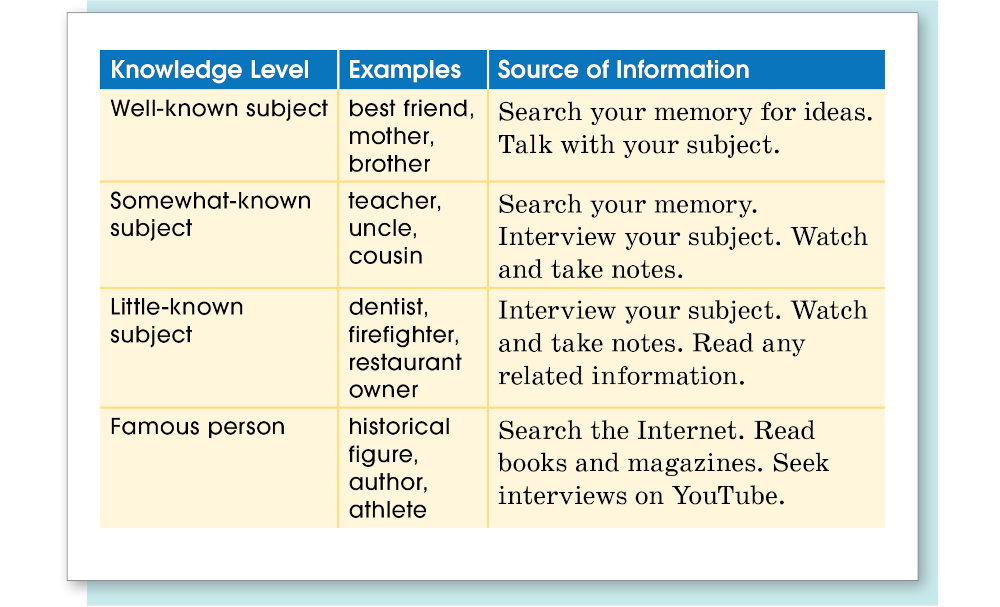
WOC 160
Page 160
Writing ■ Developing the First Draft
Beginning ■ In the beginning, spark your reader’s interest in your subject: Ask a thought-provoking question, begin with an intriguing quotation, or establish a scene. Sofia’s beginning focuses on a major achievement in Frida Kahlo’s career.
Middle ■ In the middle, include specific details that help tell your story and answer the 5 W’s (who? what? where? when? and why?). Sofia’s middle paragraphs summarize Frida’s life and focus on three major exhibitions of her artwork.
Ending ■ In the ending, explain one final important detail about your subject and reflect upon the person’s life. Sofia’s ending proposes that Frida had become an art installation in her own exhibit.
Revising ■ and Editing ■ Improving Your Writing
Use the checklist below to revise and edit your biographical story.
_____ Ideas Have I chosen an interesting subject and described an important event in the person’s life? Do I include details that make the event come alive?
_____ Organization Do my beginning and ending work well? Have I answered all of the 5 W’s about the person and the situation?
_____ Voice Does my voice sound knowledgeable and respectful?
_____ Word Choice Have I used specific nouns and active verbs?
_____ Sentences Do I use a variety of sentence lengths and beginnings?
_____ Conventions Have I checked punctuation, capitalization, spelling, and grammar?
A Closer Look at Revising ■ Voice
Your narrative voice should fit the purpose, audience, subject, and type of your writing.
■ Purpose: Sound enlightening, entertaining, and informative.
■ Audience: Sound welcoming, respectful, and engaging.
■ Subject: Sound knowledgeable, interested, and enthusiastic.
■ Type: Tell a story using a voice that draws readers in.
WOC 161
Page 161
Descriptive Essay
An effective description uses sensory details to set a scene, create a portrait, or describe an object. In the descriptive essay below, student writer Lindsay McKay describes one of her favorite places.
Times Square
Beginning:
The beginning plunges readers into the crowded chaos. Cars, trucks, and buses shoulder in honking herds on Broadway, 7th Avenue, and 42nd Street. Vehicles fill Times Square, stuck in intersections as the light changes from yellow to red. Horns wail frustration into the night.
Middle:
The writer organizes details spatially by following pedestrians. Jabbering pedestrians pick their way between the stalled vehicles and join the loud throngs on the sidewalk. They duck into and out of bright-lit shops filled with Statue-of-Liberty trinkets and Trump bobble-heads and T-shirts that profess both love for and hatred of the big city. Other people line up outside restaurant doors in hopes of tasting cherry cheesecake or pizza slices or ramen with scallions and hard-boiled eggs. Still other people gaze upward at the canyon of brilliantly lit screens that flash their ads into the night: Moulin Rouge in red, Merrily We Roll Along in white, Harry Potter and the Cursed Child in gold
Specific sensory details create vivid impressions. On one street corner, a man tries to hawk a spare ticket, and a woman and her baby beg for doggie bags. Disney princesses bumble through the crowd, pushing back their masks to ask tourists if they want to get a picture. Beside a cowboy in underwear, a man in a red jacket tries to press tour-bus flyers into the hands of a bewildered couple, who instead ask for directions to 45th Street.
Ending:
The ending sums up the description. Times Square bustles and buzzes and beeps. It babbles in tongues. It smells of street-cart falafel and dim sum and dank subways. It promises the world, but it delivers.
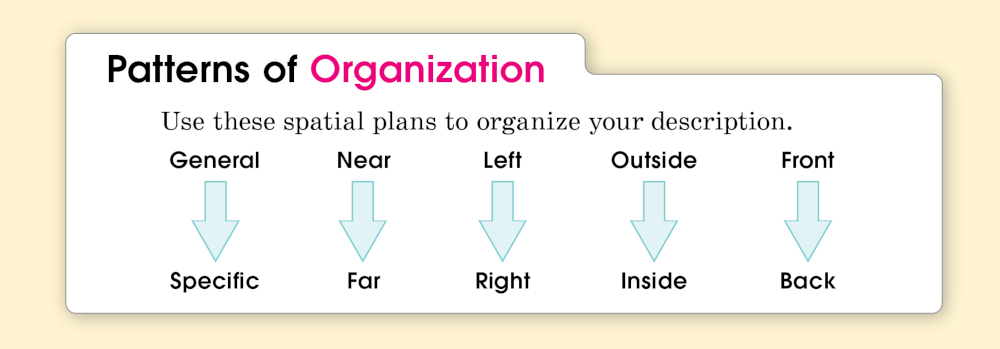
WOC 162
Page 162
Writing Guidelines
Prewriting ■ Choosing a Topic
An effective description begins with a strong topic—a person, place, or thing that you know well and would like to describe. To find a suitable topic, simply list people, places, and things in your life.
Gathering Details
Once you have selected a strong topic, gather specific details about it. If you use sensory details, you will help your reader see, hear, smell, taste, and/or touch what you are describing. Use a sensory chart to list details. (See page 149.)
Writing ■ Creating a Story Board
Beginning ■ Grab your reader’s attention and introduce your topic.
Middle ■ Describe your topic, presenting sensory details in the best possible order. (See page 40 for different patterns.) You can also reveal details as a camera would when moving through a scene in a movie.
Ending ■ Wrap up your description by providing the reader with a final thought.
Revising ■ and Editing ■ Improving Your Writing
Use the following checklist to revise and edit your description.
_____ Ideas Have I chosen an interesting topic to describe? Do I include a variety of sensory details?
_____ Organization Do my beginning and ending work well? Does my description follow a sensible order?
_____ Voice Does my voice show my interest in the topic?
_____ Word Choice Have I used strong nouns, active verbs, and effective adjectives?
_____ Sentences Do my sentences read smoothly?
_____ Conventions Have I carefully checked punctuation, capitalization, spelling, and grammar?
WOC 163
Page 163
Responding to a Narrative Prompt
Prompt:
Sometimes the worst experiences make for the best stories. What may have been miserable at the time could become funny later on. Write a personal narrative that tells the entertaining story of an unpleasant situation.
Prompt Analysis
■ Purpose: To entertain with a story
■ Audience: General audience
■ Subject: An unpleasant event that makes a good story
■ Type: Personal narrative
Planning Quick List
Trying to get to sleep
— weird noises
— cratching in the ceiling
— panel bulging
— out drops Sforzando
— cat bath
Response
A Rat in the Ceiling
Beginning:
The first part sets the scene and hints at what is to come. My bedroom is in the basement, which is the way I like it—most of the time. One night, though, I wished I slept anywhere else.
I was lying in bed, trying to fall asleep. I’d had a big day at Six Flags with my brother, but we must’ve ridden Raging Bull one time too many because my room was spinning. I clung to the bed, closed my eyes, and hoped for the vertigo to go away.
Then I heard a sound—something scraping inside the drop ceiling. “Dave, is that you?”
The scraping stopped.
Middle
The middle part builds suspense with sensory details, dialogue, and thoughts. I listened intently. At first, there was only silence. Then I heard a rhythmic thud. I held my breath, and the thudding grew quicker. I laughed, realizing it was my own heartbeat.
“Too many times on Raging Bull.”
But then the scratching started again. I lay still, straining to discover the source. It was definitely coming from the drop ceiling, in the panel right above my bedroom door. What could be scratching like that? It sounded alive!
Dialogue helps make the experience seem real. “You better not be a rat,” I growled. The sound stopped. A chill scampered up my spine. “Whatever it is, it can hear me.”
Then came a quiet little sneeze. Do rats sneeze?
Something was alive in the ceiling, and I had to find out what. I sat up in bed, swinging my feet to the floor. What could I use to defend myself? Could my algebra book do damage to a rat? What about my clock radio? Of course, there was my tennis racket beside the door. . . .
Scritch, scritch, scritch. The thing was definitely there, above the door. The ceiling tile was even bulging downward. That was one big rat!
Eyeing the ceiling nervously, I tiptoed across the room toward the tennis racket. My fingers reached out to grab it, but before they could close, a boom and scream came above my head. I looked up in time to get smashed in the face by a ceiling tile, with a huge black rat riding it down like Aladdin on a flying carpet. I shouted, and the rat yowled and crashed into my shoulder. . . .
Only, it wasn’t a rat. It was my cat Sforzando. He’d climbed into the rafters in the storage room and made his way to my bedroom. Worst of all, Sforzando was supposed to be a white cat, but he was so filthy that he looked like a black rat.
Sforzando had made sure I wouldn’t get much sleep that night, but he got his punishment. Five minutes later, he was moaning miserably as he sat in a sink full of soapy water. I had to scrub him twice to get rid of all the dirt.
Ending
The ending provides a final thought. As I toweled him off, I said, “You better stay out of that ceiling.” Sforzando seemed to understand. He’s never gotten back into my bedroom ceiling, and I’ve slept much better.
WOC 165
Page 165
Writing Guidelines
Prewriting ■ Getting Ready to Write
Analyze the prompt using the PAST strategy:
■ Purpose: Why am I writing? To narrate? To entertain?
■ Audience: Who will read my writing?
■ Subject: What topic should I write about?
■ Type: What form will my writing take?
Planning Your Writing
Choose a specific topic and decide how you want to write about it (your focus). Then form a quick list or time line, identifying the important actions as they happened.
Writing ■ Drafting Your Response
Beginning ■ The beginning of your response should introduce your topic and identify your focus.
Middle ■ Share events chronologically. Refer to your quick list for guidance, adding sensory details, dialogue, and thoughts to make the experience come alive.
Ending ■ Tie up any loose ends in the closing part and leave the reader with a final significant thought.
Revising ■ and Editing ■
Save 5–10 minutes to revise and edit your response to the prompt. (Use this checklist.)
_____ Ideas Have I shared the experience clearly and completely with specific details and dialogue?
_____ Organization Is my response organized and easy to follow?
_____ Voice Do my true feelings come through? Do I sound sincere?
_____ Word Choice Have I used the best words to capture the experience?
_____ Sentences Are my sentences smooth reading?
_____ Conventions Is my writing free of careless errors?